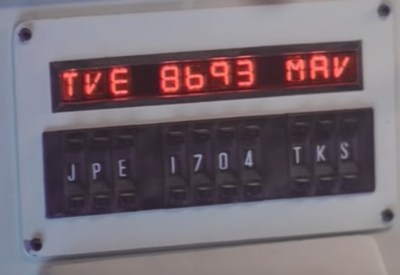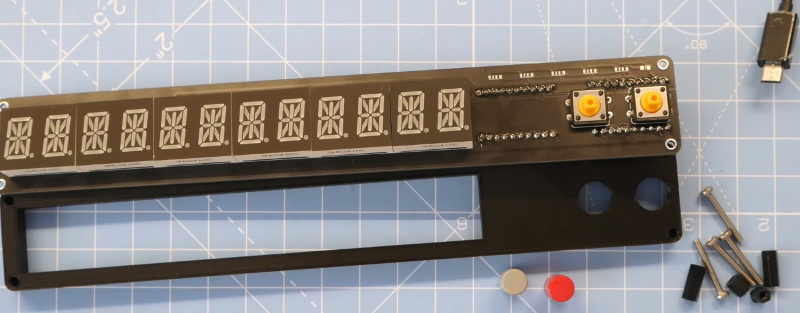Remember the WOPR from WarGames? The fictional supercomputer that went toe-to-toe with Matthew Broderick and his acoustic coupler was like a love letter to the blinkenlight mainframes of yesteryear, and every hacker of a certain age has secretly yearned for their own scaled down model of it. Well…that’s not what this project is.
The [Unexpected Maker] is as much a WarGames fan as any of us, but he was more interested in recreating the red alphanumeric displays that ticked along as the WOPR was trying to brute force missile launch codes. These displays, complete with their thoroughly 1980s “computer” sound effects, were used to ratchet up the tension by showing how close the supercomputer was to kicking off World War III.

Of course, most us don’t have a missile silo to install his recreated display in. So when it’s not running through one of the randomized launch code decoding sequences, the display doubles as an NTP synchronized clock. With the retro fourteen segment LEDs glowing behind the smoked acrylic front panel, we think the clock itself is pretty slick even without the movie references.
Beyond the aforementioned LEDs, [Unexpected Maker] is using a ESP32 development board of his own design called the TinyPICO. An associated audio “Shield” with an integrated buzzer provides the appropriate bleeps and bloops as the display goes through the motions. Everything is held inside of an understated 3D printed enclosure that would look great on the wall or a desk.
Once you’ve got your launch code busting LED clock going in the corner, and your illuimated DEFCON display mounted on the wall, you’ll be well on the way to completing the WarGames playset we’ve been dreaming of since 1983. The only way to lose is to not play the game! (Or something like that…)















“and every hacker of a certain age has secretly yearned for their own scaled down model of it. Well…that’s not what this project is.”
Finally, a non-scaled-down model that I’ve always wanted! … Oh
Well don’t get me wrong, the code breaker display is super awesome too.
A lot more so when you learn the real-life code is just all zeros.
” A lot more so when you learn the real-life code is just all zeros.”
What?! *types in code*
Because the brute force programs of yesteryear always started at 0000001, you would never hit 0000000. Simple but effective.
For values of “never” less than 100 million tries (it was actually an 8 digit code). The real reason for the 00000000 code was that Curtis LeMay was outraged by the addition of PALs to “his” nuclear arsenal, and he followed Robert McNamara around as the locks were installed making sure all the codes were set to the first thing anyone would guess. The justification was that the codes might be too hard to track down in a hot conflict, but of course this left LeMay with the ability to independently launch if he ever decided to defy his superiors — which he made lots of noises about doing over the years.
Why they didn’t just shoot him, I’ll never understand. Or at the very least retire the fucker. It’s not really funny that one belligerent arsehole who, from this example, deliberately defied the orders of his democratically elected superiors, and thereby the people, was allowed free reign to start WWIII and end life on Earth. If he didn’t believe in democracy, why didn’t he piss off to the USSR? And people used to worry the Soviets weren’t rational! Actually it’s Gorbachev who basically ended the whole balance of terror.
Did the government know he’d had the codes set to zero? Could they not have sent a team of NSA spooks with the FBI or whoever to change them all? Distract Hero Curtis with a balloon or something while they were doing it.
Seriously. We live in a world controlled by evil bastards and complete fucking fruitcakes, and those aren’t mutually exclusive.
I think the displays used in the film are Wamco incandescent (“numitron”) segmented displays with a red filter:
http://www.decadecounter.com/vta/articleview.php?item=777
Obviously nowadays it’s a lot easier to get your hands on LEDs. :)
This is correct. In the early 1980’s LED’s were still very expensive for a large industrial display you were supposed to be able to read across a room; most LED displays were extremely tiny and used with bubble magnifiers. For larger displays, Nixies were being supplanted by 7-segment gas discharge displays, which still needed high voltage but were cheaper to make, more versatile, and simpler to drive, and Numitron incandescent displays were in turn displacing the Beckman 7-segments because even though they used a lot of power and burned out occasionally they didn’t require high voltage. Flat LED displays 1 cm and larger did not really start to appear until the late 1980’s.
The tiny readouts with bubble magnifiers were common because calculators used them. Smal LEE readouts were of course used in LED watches for the brief time they existed before. LCD readouts took over.
MAN-7 readouts, and clone, were the size of 14pin DIP ICs, the readout being a tad smaller. But those were cheap enough in 1974 that I bought four of then and the TTL ICs to make a frequency, spending $30 or 40 on the readouts and ICs.
Yes, larger readouts were expensive. But I.remember various articles showing how to make your own. You just needed multiple LEDs per segment. If you couldn’t afford off the shelf, then you’d make your own, and so could a movie prop department.
A week or so ago I.mentioned the 1970. RCA Hobby Circuit Manual as a place that showed using analog meters as readouts. The book also shows how to make large 7segment readouts, though they used incandescent bulbs. By the time of the movie the knowledge was out there, as were cheap LEDs in various colors (as long as they were red, green, orange or yellow).
The numitrons were used in industrial spaces where thousands of units were manufactured. I think there may have also been availability issues with LED displays for manufacturers. Yes, LED displays this size did exist but I was working with industrial equipment at the time and nothing used them until well after 1985.
Reminds me tangentially of the SliMP3 and its display, albeit green.
That was undoubtably a vacuum flourescent display, the other major pre-LED display tech of the 1980’s. VFD’s were a bit harder to drive than the other technologies, and while they didn’t require the dangerously high gas-discharge voltages they required relatively high voltages for the less expensive semiconductors of the day.
Confirm, I own one and it is a VFD.
As cool as this looks, I can’t quite get over how dumb any cryptosystem where you could tell if you had some characters right independently of the others would be. For an 11 letter and number code, you just need to try 000-0000-000, find out which digits are zeros, then 111-1111-111 to find out which characters are ones, etc down to ZZZ-ZZZZ-ZZZ… then put in the correct code having remembered which digits were correct each time.
It’s a film! It’s meant to show increasing jeopardy as the machine guesses more and more digits. No, it wouldn’t be a practical crypto system, although it was more secure than setting the password to 00000000. Better than real life, in other words. WOPR had to factor encryption, all that headcase LeMay had to do was hear they were putting fluoride in his water.
Maybe that isn’t the intended system, maybe WOPR had detected an error in the implementation or the hardware that allowed information about the code to leak?
The dialogue probably seems to rule that out, but it’s pretty clear that no one really has a clue what’s going on with WOPR, so still plausible.
int he movie it was cpe1704tks not jpe1704tks
Not sure who your comment is for, but I use CPE 1704 TKS in my video and in my project.
The image in this article shows it as J. Which is odd cos it does seem to be an image from the film.
That is an image from inside the missile combat crew bunker. When they went to an automated system at the beginning of the movie it read: JDB 9515 VNS. At the end of the movie when the professor is telling David that Joshua is looking for the code, they pan to the missile combat crew bunker again. This time it reads JPE 1704 TKS.
Now we just need the WarGames NORAD Home Theater Room….
I would love to build one of these into a 1U server blank to add to my rack system. Do you have any instructions you can share and a board available?
I have them available on tindie – only a few left though :(
https://www.tindie.com/products/19465/
Cool idea. I need to make one.
What about the thumbwheel encoders ? I have seen some BCD or Hex a long time ago, but alphabetic ones never in real life. Do you know if they actually exist(ed)?